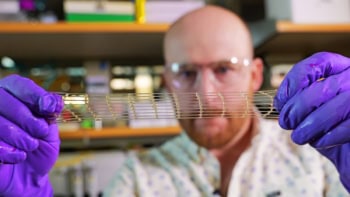The interface between bones and ligaments plays a crucial role in the human body, since it helps us to move our joints and also allows them to bear weight. This interfacial zone is composed of heterotypic, “graded” tissue, that transitions from soft ligament to hard bone, which means that it contains a complex mix of different cell types, matrix components and structures.
A research collaboration between scientists at the University of Twente and Maastricht University in the Netherlands, and the University of Pisa in Italy, recently fabricated a new type of triphasic scaffold that mimics this multi-tissue environment within the bone-ligament interface. These engineered structures could be used to develop tissue grafts that could help regenerate diseased or damaged interfacial zones.

The new biomimetic scaffold, reported in the journal Biofabrication, was made of two different materials that together reproduce the mechanical, structural and physiochemical properties of the ligament–bone interface. The first component is a 3D structure of polycaprolactone (PCL), produced using fibre deposition, which is routinely used in tissue engineering for its bone-like characteristics. This is complemented by an electrospun network of polylactic co-glycolic acid (PLGA), a bioresorbable polymer that mimics the properties of ligament tissue.
Natural properties
The scaffold was designed to have a gradient of physical and mechanical properties, similar to that found in natural heterotypic tissue. The researchers found that the combination of materials was able to imitate the properties of the bone, ligament and calcified/uncalcified fibrocartilagineous regions of tissue at the micro- and nanoscale. Since the work was published, the researchers have been further developing the electrospun network in their 3D construct.
“We are designing this structure to capture some of the physicochemical and biological characteristics of the ligament interface, including fibrillary geometrical cues, and are incorporating biological recognition sites into it too,” explains team leader Lorenzo Moroni. “Our scaffold may result in faster tissue regeneration if the recognition sites that we have engineered prove to be effective.”
Moroni explains that the work forms part of his lab’s strategy of developing biofabrication technologies that recapture the complexity of the native environment. “We are in fact trying to move from scaffolds containing a single biomimetic tissue to multiple ones in an ensemble, since it is virtually impossible to dissect a specific tissue from its associated vasculature and neural network in the human body,” he says.
Ultimately, Moroni adds, these are the first steps towards more sophisticated experiments that will attempt to connect the lymphatic network and the immune system to the regenerated tissue. “Adding the lymphatic network too would be a fascinating future development but will require more fundamental work,” he says. “For instance, we would need to culture together multiple types of cells here, which is an important challenge from the culture technique point of view.”
Towards the clinic
A more immediate priority is to test the behaviour of the new scaffold in situ. “We still need to understand if these scaffolds can be easily translated into an animal model for ligament regeneration,” says Moroni. “We have planned some experiments for 2018 to help us answer this question.”

Optimizing 3D polymer scaffolds for cartilage repair
The team has obtained funding from the European Research Council to test some of the ligament regenerative scaffolds in pre-clinical animal models. “If the results of these experiments prove promising, we will then be looking at the possibility of partnering with a company or even creating our own spin-off to further translate our findings into a product that could reach the clinic,” he continues.
One purpose of those tests will be to evaluate the lifetime of the regenerative products. “Ideally, the materials we have used should provide a long-lasting solution, but this is still a challenge to achieve,” Moroni concludes.
- Read our special collection “Frontiers in biofabrication” to learn more about the latest advances in tissue engineering. This article is one of a series of reports highlighting high-impact research published in the IOP Publishing journal Biofabrication.



